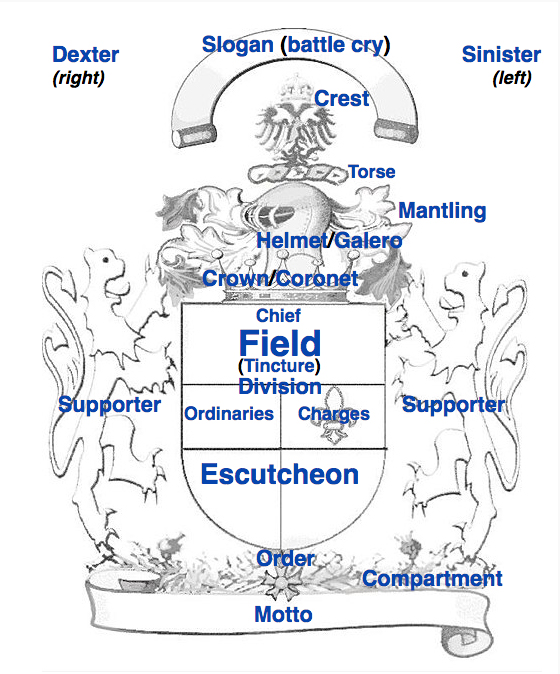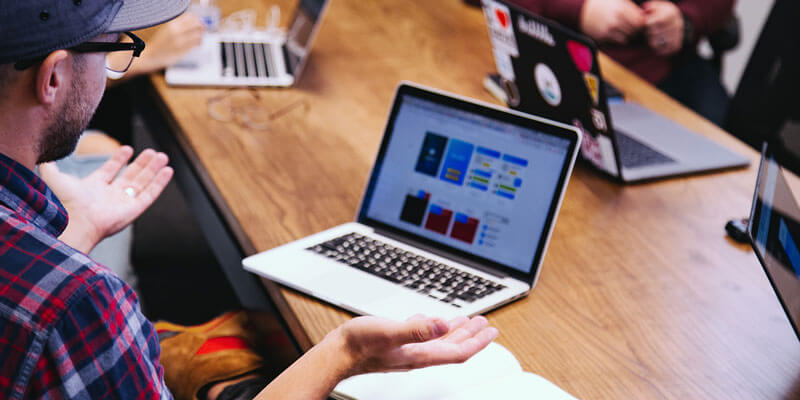
Do you ever wish you had a dedicated member of your team who delivers quality graphic design work, on time, for an affordable price? Someone who won't take up office space, or require a salary, or NI contributions, or a pension, or staff benefits, or constant refills of tea and coffee, or a week off in June for their friend's wedding, but is always there for you whenever you need them? A person who completely understands your needs and will give your business a professional brand identity or make your products more eye-catching to potential clients and customers? Maybe it's time to get clued up on the benefits of using a freelance graphic designer.
Freelance graphic designers enjoy working with you
Freelance graphic designers love producing creative solutions to your specific business needs, whatever they may be, whenever you need them. They have the time to be creative and come up with exciting ideas when you're snowed under with other jobs that are demanding your attention. A freelance graphic designer enjoys working with you on projects and helping your business to become more established and presentable, without distracting you at all times of the day by popping their head round the corner to ask you annoying questions!
Unlike a lot of people, freelance graphic designers ask for MORE work!
When you work with a freelancer you will soon realise they never moan that you're giving them too much work to do, or tell you that other deadlines have to take priority before they can even think about starting on your project. And then, when you don't need them anymore, a freelance graphic designer will never be sat around the office twiddling their thumbs, complaining that you're not giving them enough work. They'll be out there somewhere, costing you zero time and money, living their creative freelance life, waiting for your next phone call, or email, ready to work for you again, whenever that may be.
Now you know the benefits of using a freelance graphic designer, it's over to you
Hopefully this article has helped convince you of the benefits of using a graphic designer. Working with a freelance graphic designer is cost-effective and stress free. And if it's your wedding next June, they might even design your invites. So the next time you need some branding, a new website design, or a logo for a your new venture, or a brochure for the services that you offer, you'll know what to do.
In this I'll be presenting some brilliant examples of minimal heraldic logo design. To provide some context, I'm currently looking at refreshing my business brand identity and updating my website to better communicate what it is I have to offer potential clients as a freelance graphic designer. One of the logo design options I've been looking at for inspiration has been my family coat of arms, or more accurately the 'heraldic achievement' of my family name, Cowan. A coat of arms is actually just one part of the broader heraldic achievement, and for anyone confused by all the terminology Wikipedia explains the relationship thus:
A coat of arms is an heraldic visual design on an escutcheon (i.e., shield), surcoat, or tabard. The coat of arms on an escutcheon forms the central element of the full heraldic achievement which in its whole consists of shield, supporters, crest, and motto. A coat of arms is traditionally unique to an individual person, family (except in the United Kingdom), state, organisation or corporation.
While looking into how I might use my family heraldic achievement as part of a logo for my freelance graphic design business I started looking into other recent logo designs inspired by heraldry. I found that there's actually quite a trend for minimal heraldic logo design, where designers use existing emblems and badges to create modern, refined logo marks as part of wider rebranding projects. From what I've found so far these logos are most often for some kind of geographic entity, such as a city, rather than for smaller companies. I have also discovered designers who specialise in creating contemporary heraldic logos. I thought it would be a good idea to feature some of the best examples of the designs I have come across so far. For more examples you can check out my specific Pinterest board. It's worth pointing out that while some of these are 'real' redesigns, others are conceptual projects by individual designers.
Examples of minimal heraldic logo design
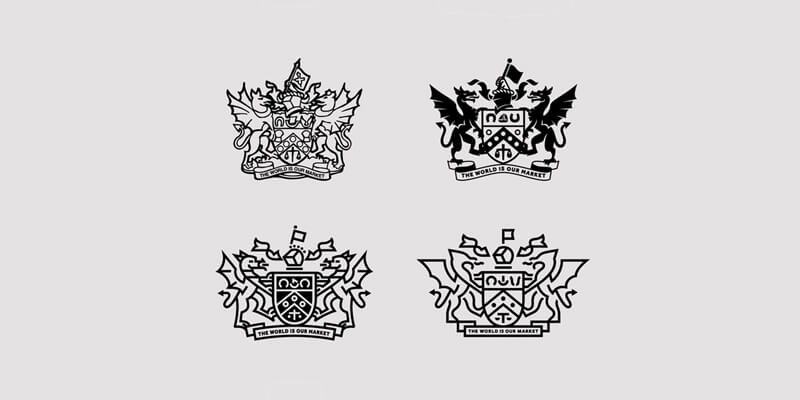
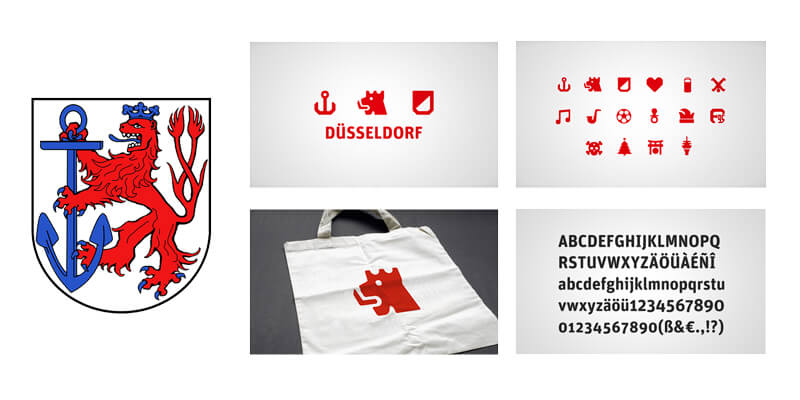
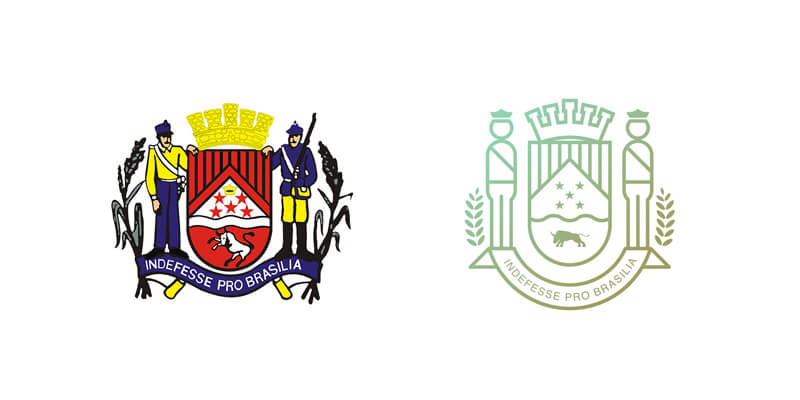

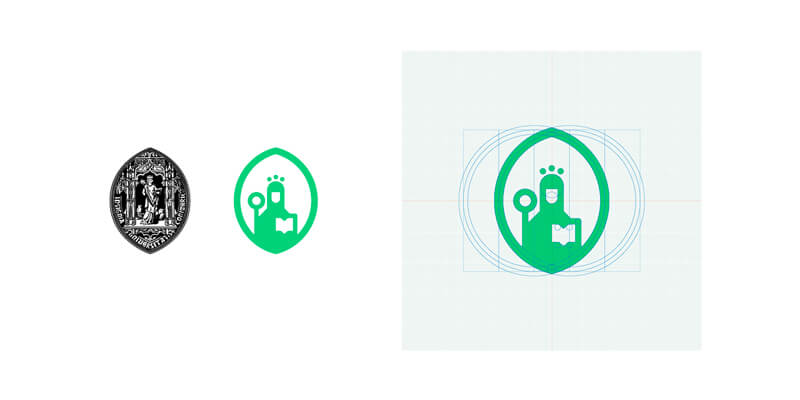
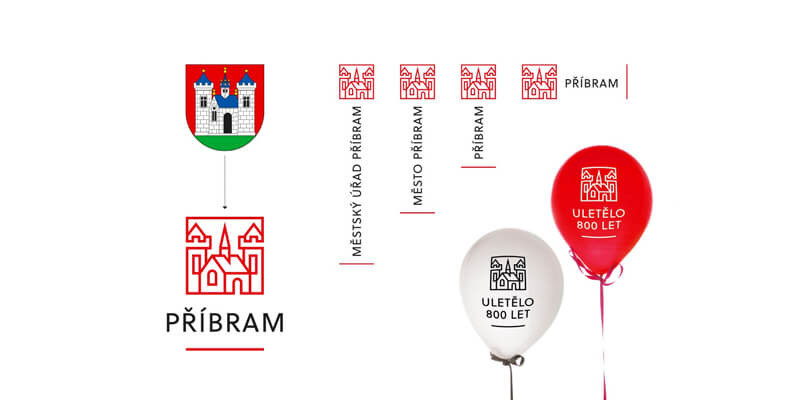
Taking inspiration
I'm looking forward to creating my own minimal heraldic logo design soon. I am drawn to the most minimal examples I've presented here, such as the fish mark for the city of Aš. I think a complete heraldic achievement would be a bit too much for my own business use. I also want to play on the idea of being a freelancer, and the original meaning thereof. As a Birmingham-based graphic designer I'm also thinking about a just-for-fun project updating the Coat of arms of Birmingham. Watch this space, and do let me know if there are any other examples you think I should feature.
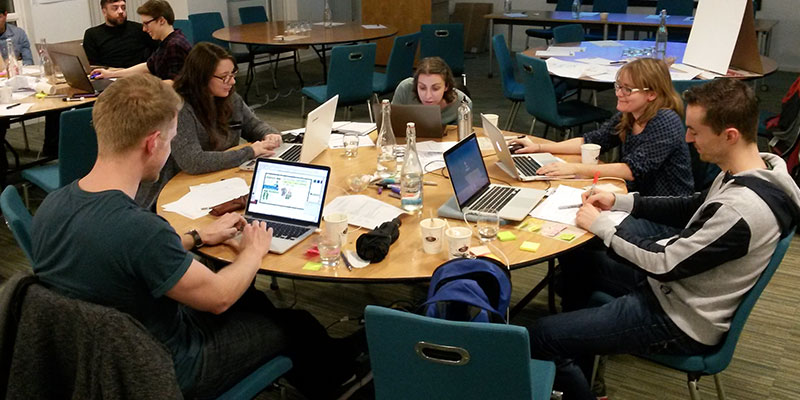
There's something I just love about designing infographics, and so I was very happy when Peter Moore Fuller, Designer Director of Made Agency invited me to participate in the recent env.infohackit event at Birmingham University. The idea behind env.infohackit is that teams of designers and PhD students work together designing environmental infographics over an intense 12-hour period.
The overall aim of the event was to help the attending PhD students develop their ability to communicate their research in the compelling visual form that infographics have to offer. However, there was also some friendly competition in that all the teams were competing for the coveted 'first prize' on the day, which would also mean having the opportunity to present their winning infographic at envEXPO later in the year. I also saw the event as an opportunity to meet with some other local creatives and dip my toes back in academic waters.
Meeting the other creatives
The event was hosted on Birmingham University's Edgbaston campus, in the Nicolson building located adjacent to the beautiful Winterbourne House and Gardens. I arrived at around 8.30am and walked into a room already buzzing with what looked like very eager PhD students (I think the free coffee will have helped!). On looking at the PowerPoint slide being projected against the wall I saw that the event had actually started the day before. I had a mild panic about being a day late, until I met with Peter and he explained that the students had spent the previous day getting a solid grounding in how to use Adobe Illustrator. Peter then introduced me to the other designers taking part in the event, Patrick (patrickjohnson.eu) and Kevin (www.kevinbishop.co.uk), who were both really nice guys. We talked about not knowing exactly what to expect, but we were all looking forward to getting started.
Meeting my team
After a brief welcome, Peter informed us that our task was to work together as a team to produce an infographic in the time remaining (which was roughly 12 hours). The theme of the infographic could either be drawn from the research of individual PhD students, or could reflect a broad theme of shared interest among the team. Peter then allocated Patrick, Kevin and myself to our teams; I was put with Sam (studying oil field reclamation), Hannah (transport and telecommuting), Ulrike (microfossils and climate) and Milan (using social media to predict pandemics). It soon became clear to us that there was a broad theme among our team's research of global environmental change, and we decided to focus on something to do with climate change. After discussing a few alternatives we decided that we would create an infographic that conveyed information to primary school children about the impact that small, daily activities could have on the larger challenge of addressing a changing climate. What took slightly longer was creating a team name, but in the end we settled on SHUMO - an acronym of our first initials.
Creating the Team SHUMO infographic
We had a clear idea of our audience, and so we started discussing ways that we could connect with them. One of the team mentioned that we could present our data using the hook of 'becoming a climate superhero', and we therefore decided to create five different heroes for each of our routine activities. All of my team were new to Illustrator, and had 'enjoyed' the previous day's training to varying degrees. Milan had renamed it 'Adobe Frustrator', which made me laugh as I remembered my own early experiences with the software. However, we decided that we would each take responsibility for representing the data relating to one of the five areas/heroes. On top of this, Sam decided she was up for the challenge of creating the superheroes that would accompany each section.
In both my freelance and in-house work I am used to taking on responsibility for everything, so I enjoyed the change and challenge of having more of a 'Creative Director' role. I spent some time moving between group members, helping them do things like set up grids and learn useful shortcuts for different Illustrator tasks. Even though I didn't expect them to stick to the grids I suggested, I wanted to convey that what really helps when working with creative tasks in Illustrator is a sense of structure, and that although it takes time to learn how to use it quickly and effectively the time invested is ultimately rewarding.
As each of the team were making the individual components of the infographic it was my task to put it together. I collected the graphics from each of the team and made decisions over typography and colours. I didn't have time to really consider any of these, so for me it was very much a case of producing something good enough without obsessing over the details. This was actually quite freeing, and it was actually really good getting immediate feedback from everyone on what they liked and didn't like. One thing I enjoyed was Milan's constant mantra throughout the day of "keep it simple". He may not have warmed to Illustrator but he definitely had the right mindset for design work!
After 12 hours had flown by, punctuated by breaks for lunch (cold buffet, with soft drinks), dinner (hot buffet, with beer) and Peter's QI-style countdown klaxons we were done. The improvement in each of my teammates' abilities in Illustrator was really impressive to see. It also turned out that Ulrike had been using Illustrator CS4, which meant she was working without some of the tools and functions that were available to the rest of us. She, together with Hannah, Sam and Milan, had all come a long way in a short time, and had even managed to create a great PowerPoint presentation to help 'sell' our infographic.
Presenting the infographics
Peter gave a typically humorous summary of the past two days before inviting each team up to present their infographic. We were the last team to present our work, and so we enjoyed seeing what the others had come up first. I have to say that the quality of not only the infographics but also the ideas that informed them was fantastic.
Product of 11hrs work, loved almost every minute of it... nah it was awesome! Thanks @infohackit #adobe #graphics #design pic.twitter.com/TkgObO7bcI
— Jack Richardson (@Jack_Seeds) January 17, 2017
One of the teams (The Pipe Pundits) didn't have a designer working with them, but had still managed to create an intricate and very clever schematic-styled infographic relating to risks around pipes. I thought that would be the winner, but the other teams then showed their infographics which were just as impressive.
Fantastic result... #infohackit pic.twitter.com/t4fMWbpzPW
— infohackit (@infohackit) January 17, 2017
The next was a minimal and classy 'Sunday supplement' style infographic about how human polluting activity can lead to endocrine disruption in fish (Patrick's team - amusingly called the Gender Benders because one of the main impacts being a change/disparity in fish sex ratios). Patrick explained the ideas behind the design, using naturalistic ideas of cycles, flows and funnels to dictate the overall aesthetic.
Thought you might like to know some #facts on #climatechange Mr. @realDonaldTrump #infohackit #climatechangeisreal @studio_MADE @algore pic.twitter.com/Tv3pWxhyb8
— Kevin Bishop (@KevinBishop_) January 18, 2017
There was then a very entertaining and nicely put together infographic debunking the idiotic climate tweets of Donald Trump, put together by Kevin and his team. Kevin also came up with the great title of "How to overcomb climate change, folks!". I was amazed by the quality of ideas and detail in each of the infographics. Each of them had a very different style, and ours was no exception!
[pt_view id="76f24benea"]
The rest of Team SHUMO did a great job of presenting the ideas and process behind our infographic to everyone else (I was quite frazzled by this stage and more than happy to take a back seat!). The other teams seemed to enjoy the fact that each of our superheroes was based on a specific Team SHUMO member (I was the 'Leccy Lantern', obviously). Our infographic was possibly lighter on actual 'information' than some of the others, but this was a conscious decision as we wanted to focus more on 'actions' than facts. The facts we did include were presented in ways that were consistent with our superhero theme; we didn't sequester CO2, we 'crushed carbon!'. After some questions from the audience it was time to grab another beer while the judges conferred.
Team @shumo and their alter egos #infohackit pic.twitter.com/K8cWCRWKnc
— infohackit (@infohackit) January 17, 2017
And the winners are...
After teasing us via his PowerPoint mastery (and giving a prize for the best Day 1 vector illustration), Peter revealed that the winners were... Team SHUMO! We were a little shocked, as I don't think any of us had expected to win. We were all very pleased though, and I think everyone was proud of what we had come together to do and had achieved, in just 12 hours. After being given a bottle of celebratory fizz we posed for photos and chatted before saying our goodbyes and heading out into the misty, drizzly Birmingham night.
And the winners are ... team Shumo!! #infohackit pic.twitter.com/fhHyksLAv7
— infohackit (@infohackit) January 17, 2017
Thoughts on the day
I am really pleased that I took part in env.infohackit. The passion and interest of everyone at the event was clear to see, not only among the academics but also in Peter who was an excellent and accommodating host. Seeing the growth in my teammates' abilities was fantastic, and I was pleased to hear that they were thinking about how they could use their new-found skills in communicating their own work. For me personally, I enjoyed playing the role of facilitator and director and had a lot of fun working with Sam, Hannah, Ulrike and Milan. I even learnt a thing or two about letting go of my own perfectionism and seeing what is possible in just 12 short hours. It was great to be on the winning team, but I would have been just as happy with a day well spent if we hadn't won. I met some great students and it was really good to get to know some talented Birmingham-based designers in Patrick and Kevin. Now my team go on to present at envEXPO, and Leccy Lantern wishes them the best of luck with that and with their PhDs!
Today's guest designers - gentleman all... Patrick, @ollycowan and @KevinBishop_ Thanks so much for coming!! #infohackit pic.twitter.com/4umxqB6MJc
— infohackit (@infohackit) January 17, 2017
#infohackit Birmingham survivors 🙂 pic.twitter.com/M5zVPHtNoi
— infohackit (@infohackit) January 17, 2017
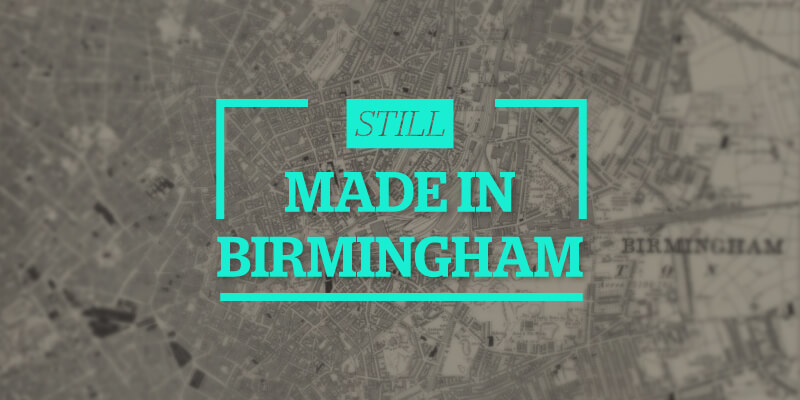
A short history of things made in Birmingham
2016 is the 850th anniversary of Birmingham being awarded a market charter and in its many years as a commercial settlement it has been known as 'the city of 1001 trades' and 'the workshop of the world'. In 1791 Birmingham was hailed as the first global manufacturing town, and even though it wasn't solely made in Birmingham the city was at the heart of the Industrial Revolution.
Although Birmingham’s industrial heyday has long since passed it retains a strong identity as a centre of invention and craftsmanship. Aside from the fact that a third of the UK’s jewellery is still manufactured in the city, there are many different trades and crafts that continue to serve the city and the wider world. I was reminded of this when attending events during Birmingham Heritage week in September, and as someone who works with businesses to develop their brand I thought it would be interesting to find out more about the identities of Birmingham’s oldest companies.
Firmin & Sons Ltd (founded 1655)
Firmin & Sons Ltd has been designing and manufacturing insignia, buttons and ceremonial accessories since 1655, making it older than the Bank of England. The company started out producing buttons and soon moved into making uniforms, liveries and badges. According to the company website they supplied buttons to both sides in the American Civil War, currently produce the uniform of the Household Cavalry and have a Royal Warrant of appointment.
Firmin & Sons employ around 150 craftsmen and women, with skills being passed down from one generation of workers to the next via the time-honoured system of masters and apprentices.
Westley Richards (established 1812)
While many people are familiar with Birmingham’s Jewellery Quarter, perhaps fewer know that it also has a Gun Quarter. The two are actually close neighbours, with the Gun Quarter being located in a relatively compact area north east of Snow Hill railway station, bounded by Steelhouse Lane, Shadwell Street and Loveday Street. Once home to a thriving firearms industry, much of the area is now industrially fallow. However, the gunmaker Westley Richards has been operating there since 1812, and recently celebrated its bicentenary.
Founded by William Westley Richards with the goal “to be the maker of as good a gun as can be made”, the company has a long history of innovation and craftsmanship. Today Westley Richards is the only gunmaker founded in the 19th century still operating in the Gun Quarter, staffed by “highly trained craftsmen and a team of lively young apprentices”.
Vaughtons (founded 1819)
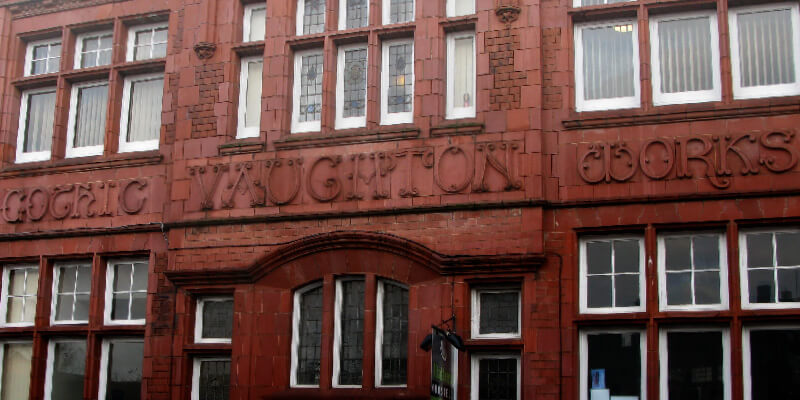
Founded in 1819, Vaughtons is located in the Jewellery Quarter and is a specialist manufacturer of automotive badges, medals, and civic regalia (think chains of office, the things mayors wear). Founded by Phillip Vaughton and listed as a “Buttonmaker, Medalist and Mint”, Vaughtons has had a few premises in its time, but moved to the Vaughton Gothic Works on Livery Street in 1903 and has been there for 113 years and counting.
Vaughtons produces a wide range of quality bespoke insignia, with a recent example being the badges it created for a special edition Aston Martin. They are also well-known as a medal-maker, having manufactured medals for the Football League since 1911, and more recently the Carling Cup Final medals in 2012.
Acme whistles (founded 1870 as J Hudson & Co.)
Acme Whistles is the contemporary name for the company that started out as J Hudson & Co in 1870. Derbyshire native Joseph Hudson started a workshop (in the washroom on the side of his rented back-to-back!) to help supplement his family by repairing, making and selling anything he could. His first manufactured goods included snuff boxes, corkscrews and whistles.
The whistles really took off when the Metropolitan Police began to look for a communication device that would replace their ineffective rattles. J Hudson & Co was well placed to deliver what the Met needed, and since then have developed whistles for use in a wide range of contexts, including the military, dog training and sports events. They also have some great product names, including the Thunderer, Tornado and Cyclone.
Trading as Acme Whistles since the year 2000, the company continues to develop new technology to improve the design and use of their whistles.
Brooks England Ltd. (founded as J.B. Brooks & Co. Limited in 1886)

2016 is the 150th anniversary of the Brooks England, founded in 1886 by John Boultbee Brooks. Legend has it that after his horse died he was forced to cycle to work and found the saddle so uncomfortable that he created his own. in 1888 the Brooks B17 saddle was launched as “a neat, light saddle, of best quality”, and has remained a bestseller ever since.
Originally based in the city centre near New Street, as Brooks expanded the company moved to larger premises next to Snow Hill station, before shifting to its current location in Smethwick in the early 1960s, following a takeover by Raleigh Cycles.
Brooks is world-renowned for its hand stitched leather cycle saddles, but has in more recent years diversified into a wider range of cycling equipment and accessories . This shift in gear has partly been due to the direction of current parent company Selle Italia. In fact, while on holiday in Italy this year we came across a big display of Brooks merchandise in a Lucca gift shop - surreal but cool to see a little piece of Brum when you least expect it.
Looking to the future
The five companies I’ve covered have all been so successful for various different reasons, but what they have in common is their dedication to innovation and producing goods of the highest quality. Having been around for so long they have each encountered interesting twists and turns in their development from sole enterprise to manufacturing legends, and I urge you to read more about each of them on their company websites.
If you want to find out more about the role that manufacturing, invention and innovation have played in the development of Birmingham’s economic and cultural identity then check out the book Birmingham: The Workshop of the World by University of Birmingham academics Carl Chinn and Malcom Dick. Published in 2016 to mark the 850th anniversary of Birmingham’s market charter, the book is the first major history of Birmingham to be published since the 1970s.
I feel like I’ve learnt a lot while researching this post and feel proud to be making a small contribution to the developing identity of a Birmingham as a hub of craft and creativity in the 21st century.
"As far back as I can remember, I always wanted to be a gangster."
So goes the famous line from Goodfellas, spoken by Ray Liotta’s character Henry Hill. It’s a great line, a memorable line. Outside of the glamour and excitement he saw in the gangster lifestyle, what he really wanted was belonging, as he goes on to say:
“I knew I wanted to be a part of them.”
The tough choices
If Ray Liotta was narrating my life (it could happen…) he wouldn’t have quite as much exciting material to work with. It would probably be something more like:
"As far back as I can remember, when faced with a choice I struggled to make my mind up".
Not nearly as memorable a line. But for me, it captures something that I always struggled with. My brother still laughs at me because on my 8th birthday I burst into tears in a toy shop when I couldn’t decide which Airfix kit to buy with my birthday money. There was just so much choice!
Going with the flow
In school I was told I could do anything I wanted when I was older, because I was pretty good at most of my subjects. However, this was quite overwhelming for me. Faced with all that choice I couldn’t decide on any one particular thing. I hedged my bets, choosing a broad range of A-Levels and putting off any decisions until later. I applied to do the same degree as one of my best friends (Criminology), and then went on to postgraduate study (because another one of my friends was doing it). After six years of PG study I eventually earned a PhD in Criminology.
White-collar crime
A lot of people are impressed by me having a PhD. At parties I used to get called a lecturer when people introduced me (I was a part-time Teaching Associate for a while, but never a lecturer). People used to ask my opinion when there was a crime-related story on the news (and the news being what it is, this was very regularly!). The problem was, it never felt like ‘me’. When people called me a lecturer I felt like a middle-class fraud (there’s a criminological term for this — white-collar crime!). I never had the confidence or drive to try and make it in academia, because it wasn’t my passion. In short I didn’t have an identity.
Coming clean
I knew this couldn’t go on. I was miserable, lacking in confidence and felt like I wasn’t getting anywhere. Some close friends and family gave me some amazing support and resources to try and help me figure out what the hell I should do with my life. One of these was a book called Strengthsfinder. It’s a bit ‘corporate’, but it helped show me how to match the kind of person I am with the kinds of things I might want to do. It helped me see that I have strengths in empathy, ideation and maximising. In short, I am good at understanding people, coming up with ideas and making the most of situations. I volunteered at a local primary school, started a qualification to become a personal trainer (I love all things to do with health, fitness and wellbeing) and began to do dabble at designing posters and t-shirts, mainly as gifts for friends.
Starting a new life
What I liked about graphic design was that it brought all my strengths together in one package. I like novelty, making connections between seemingly disparate things and just trying to make things ‘better’ in my own way. I devoured YouTube tutorials and online articles about the principles of graphic design. I started working on my own little projects, and people kept asking me to do things for them. I even contributed to a criminology conference...as a designer rather than a speaker! I was getting better but I knew I needed some help in order to get to where I wanted to be. I sent CVs and portfolios to graphic design agencies in Birmingham (which is where I live) and eventually secured an internship at an amazing agency in Wolverhampton called Mediaraft.
'I knew I wanted to be a part of them'
To go back to Goodfellas, working with other designers and as part of an exciting agency reaffirmed to me that this was what I wanted to do with my life. I began to feel more and more comfortable and sure of myself, and although I was new to the design game I had the desire and drive to make it work. Just over a year after I started my internship I now work as the sole in-house designer for an SME, and continue to learn new skills and practices every day.
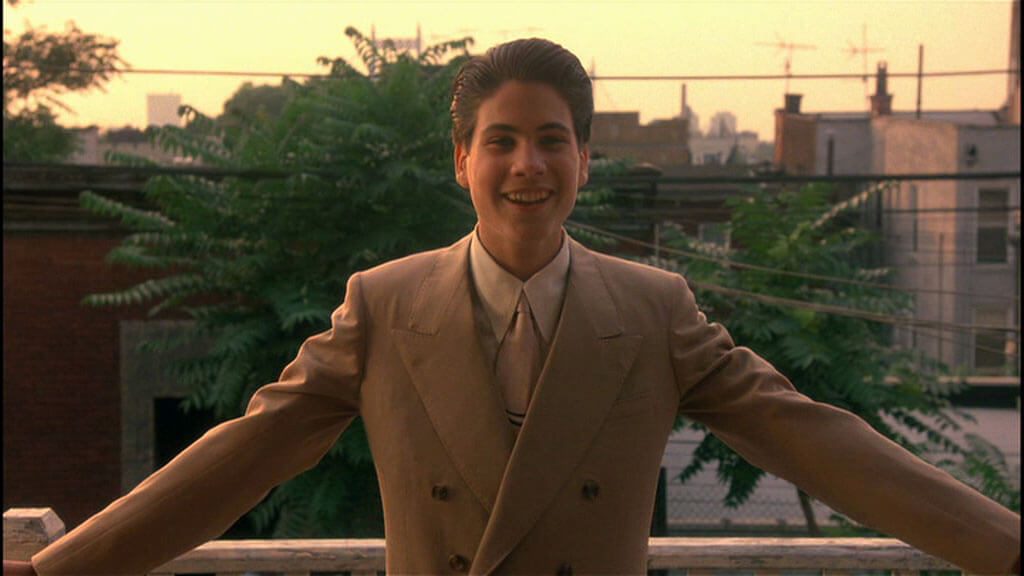 Now I have my identity, let me help you with yours
Now I have my identity, let me help you with yours
The funny thing is that now I have more of an identity I find it a lot easier to make choices in life, which includes helping others with identities of their own. If you have a business that needs a brand, or a project that needs a persona then I would love to hear from you. You should definitely check out my portfolio to see some of my featured work, or follow me on Instagram to keep up to date with my work-in-progress and illustrations.
Thanks for reading!
